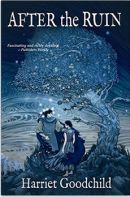by Harriet Goodchild (Hadley Rille)
After the Ruin is a retelling of the classic boy-meets-girl story. The background for this particular romance is the high fantasy kingdom of Felluria where the immortal (beautiful/tragic) Marwy Ninek rules. Her one-true-love, Assiolo, arrives on her doorstep as a nameless beggar (who is also a magician/prince) and it is love at first sight. He deals with a problem from her past that has been plaguing Felluria for decades and they settle down to a peaceful life.
But forces beyond their love are stirring. The immortal beings Averla and Kenu Vanithu are battling for control with all the world as their chessboard and the life of Te-Meriku, the wild, powerful, red king of Lyikené, is at the center of their plotting. The lovers are separated as the balance of the world shifts. Years go by and they are left alone, trying to find each other and a future together before the fate of the world is decided.
Now, I love fantasy as a genre and I adore folklore influenced tales, which After the Ruin clearly is). I really wanted to like this book. But, sadly, I didn’t.
First off, I found the language somewhat clichéd and flowery: pretentious for a romance/adventure. Most of the book was spent wading through writing “style” to get any sense of the characters at all. Next, the book begins with a flashback rape scene. I find rape in characters’ backstories to usually be a negative because they follow a simplistic pattern: the woman is raped, it breaks her, and she stays damaged until a kind man comes along to show her that sex/love can be better. This narrative leaves the woman with no agency and cheapens her healing process. It feels like a shortcut to explain both why she is broken and why Assiolo is the only man for her.
Other (far less egregious) character shortcuts were used frequently in After the Ruin. Almost all of the women are either sweet & innocent (Marwy Ninek) or manipulative & underhanded (Averla). The number of times that phrases like ‘because they were men (or women) of . . .’ shows up is problematic, too. Often the people in the book, including Assiolo and Marwy Ninek, felt like two-dimensional caricatures.
Plot-wise, most of the major action in this novel seemed to occur offstage. The important turning points where you would expect to see character development and paradigm shifts occur in a few paragraphs that are scattered amidst endless, flowery descriptions of everyday life. For example, Assiolo’s transformation (upon which the climax of the entire novel hinges) happens in a few sections mixed up in several chapters where Averla holds him prisoner. He leaves under his own power, defiant and seemingly very much the same character he was when he arrived. I know he was there for five years because the author says so, but it takes up very little space in the actual story. However, when he arrives home at last, he does things that are completely out of character. How he came to be so different is never made clear.
On the heels of that, the story of Marwy Ninek’s revenge and the resultant mess could be a book all to itself. Like many major developments in this book, the tragedy was cheapened by the brevity with which it was dealt. A lot of the backstory didn’t come up until well after the situation was over so I just didn’t care when the monster was finally defeated. It also felt like the hero went, dealt with it, and came back with no believable obstacles.
Plot inconsistencies were yet another issue. Example: Marwy Ninek can’t have children because she is an immortal and (as we are reminded in almost her every scene) not human. And yet, her parents –who made appearances as minor characters in flashbacks—somehow had her. Her mother also had a son who then went on to father a daughter. So why is Marwy Ninek the only one whose heritage makes her barren? This wouldn’t be such a big deal if her inability to have children didn’t lead to a major plot development.
There comes an unfortunate point in some stories where characters are too stupid to actually live. The end of this novel is one of them. I really can’t sort out why, when Assiolo seems to have always had the power to go up against Averla, he doesn’t choose to use it until the least opportune moment. I also never worked out why he didn’t listen to all of his trusted friends or bother to have a chat with his beloved before leaping blindly into the final battle.
The one redeeming character in this book was Te-Meriku. He is the only character who seems three-dimensional. He is flawed and unexpected and human even though he is surrounded by cardboard cutouts and stilted dialogue. His own past with his one-true-love is the only romantic tragedy in the entire story that touched my heart. I wanted the rest of the story to come through with the clarity and humanity that his part did.
Overall, I found After the Ruin to be a frustrating read. There are bits and pieces of an interesting novel buried under over-written prose, not enough attention to detail, and reliance on cliché. I might be talked into reading something else from this author in the future because there were a couple of moments of real emotion and unexpected humanity, but I would have to be in a patient mood.
–Kate O’Connor for Abyss & Apex

